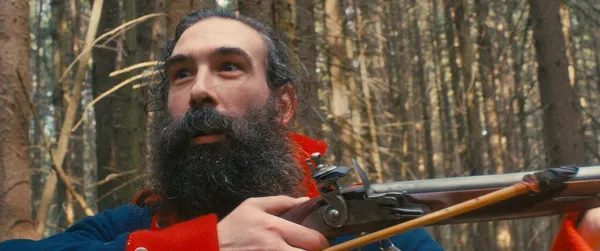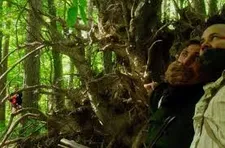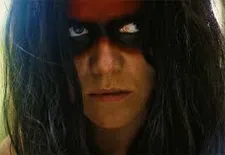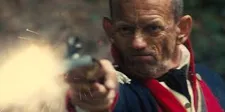 |
| Lost in a forest |
Set during the War of 1812, Ted Geoghegan’s Mohawk is a thrilling drama which sees two Mohawk people, Oak and Calvin, and their British agent partner Joshua, try to escape a murderous group of American soldiers. In the first part of our interview on the subject, Ted and I discussed the history of the period, the way he researched the film and his approach to casting. In the second, we look at his approach to shooting in the forest and making the film authentic, and why he feels that in today’s world, political art is vital.
Unlike other films which generate fear in forest settings, Mohawk opens with a landscape that feels unthreatening. I ask Ted why he chose this approach.
“I took a page from the John Boorman film The Emerald Forest, which is an absolute masterpiece of cinema that creates this amazing tension in this beautiful, beautiful landscape,” he says. “I’ve seen so many genre films over the years – everything from Blair Witch to the new film The Ritual on Netflix – wonderful films, all of them – that use the forest’s darkness and terror as one of the movie’s greatest impetus towards fright. I wanted this film – similar to The Emerald Forest – to be a movie set in a place of beauty. I wanted it to be an untouched landscape that you’d want to go to. It’s the people who are there who are ultimately what creates the horror.
 |
| Hiding from the enemy |
“We set about, early on in the film, to make it look as magical as possible. We shot the film with natural light, something that films typically never do, which creates a very stark brightness to the film but it also creates a bit of a glimmer that you traditionally don’t see in mainstream cinema, so that these initial sequences as our characters are discovering what’s occurred and running have a real essence to them, and as the film progresses...” He hesitates, trying to avoid spoilers. “After the mission sequence, the forest starts to die. We are no longer seeing the leaves as we did before. The trees themselves are sharper, they’re more jagged, they’re more imposing. Ultimately the finale of the film, which takes place that evening, is drenched in darkness and in soot and in fire, in the ultimate interpretation of the death of a forest.
“We shot the film in two locations just outside of Syracuse, New York, very close to actual Mohawk territory, and we shot with the Parks Commission there. We did a lot of scouting very early on with the film to ensure that we had the proper locations for every scene. We wanted every moment in the film to feel somewhat different yet eerily familiar, to create the idea that these characters might be walking around in circles or they might constantly be going in the right direction but we can’t tell, similar to what it’s like when you actually are in the forest.”
Some of the scenes involve fires lit in the forest by characters who don’t look as if they’re taking much care not to set it alight. How did he ensure that this was safe to film?
“We thankfully were working very closely with the Parks Commission, who gave us the opportunity to have moments like that in the film. They were all under close supervision. While there are a few shots in the film that feature real fire, in which circumstances we would have fire department and extinguishers on hand, there are a few moments in the film where we were able to use vapour to mimic the reality of smoke. Whenever fire is not directly seen on camera it is typically vapour, like the type of vapour you would see coming out of an e-cigarette, which helps make the set as safe as possible and keep the forest as pristine as possible. Obviously, when working in these beautiful areas the last thing we would want to do is leave them any different that when we first arrived.”
Setting the right tone went beyond the work in the forest itself.
“When we were developing the mood of the film, the scenario that we kept running over in our heads was that we are telling a very important story and we have to treat it with the respect that it deserves. Utltimately this is a chase film, ultimately this is a historical drama, this is an independent film about people running for their lives but it’s also an actual point in American history, and we had to acknowledge that at all times.
 |
| Kaniehtiio Horn |
“I recently screened the film in Syracuse, New York, and I was deeply honoured to see about two dozen Mohawk people who had driven in to watch the film, many from the nearby reservations. After the screening a Mohawk man came up to me – an elderly fellow probably in his seventies – and put his hand on my shoulder, and he told me ‘The things that happened in your film were real. Don’t ever forget that this is not a work of fiction.’ And it really struck me, a that moment, that realisation. Obviously, throughout the entire process, we knew that we were telling a story about real people, but to talk to a man and to hear those words come from someone after just seeing the film really moved me a lot and really helped remind me how important it is to tell stories of indigenous people and marginalised people and to get those messages out there.
“I am definitely a changed person after having made this movie and I’m going to be devoting a lot of my life to make sure that these marginalised voices, be it based on the colour of their skin, there gender or who they love, that these stories are being told, and hopefully by the right people.”
I note that in recent years I’ve started to receive more requests to write on Native American films, which used to be vanishingly rare. Does Ted think there’s a growing movement that will see cinema tell more Native stories?
“I certainly hope so. I never quite know, with any of the trends that happen in cinema, whether they’re here to stay or whether they’re a passing fad, but the idea of more visibility of Native peoples – it cannot just be a fad, it needs to be acknowledged. The Native People, the First Nations people, the aboriginal people of North America, their stories have to be heard. I sincerely hope that this movement starts a trend of more Native actors, directors and writers having the opportunity to have their stories told. I, as a white man of European heritage, feel deeply humbled to have been given the opportunity to tell this story about these amazing people… It’s something that I’ve put my heart and soul into and to see the film embraced by the Mohawk Nation has meant a lot to me. To see Mohawk people watch this film and feel moved by the story that we’ve told is greater than anything I ever could have imagined receiving from this project.”
Another interesting aspect of his film is that it features a happy polyamorous relationship, something hardly ever seen in cinema.
“When talking about marginalised groups or groups that we typically do not see much of in cinema, to me it struck a chord as another opportunity to be able to include something that one doesn’t traditionally see in film. The idea of this healthy polyamorous relationship between these three people, all of whom deeply love each other, I thought, not only am I able to tell this story and crate this awareness, but also I felt it deeply strengthened the bond between these three characters. I can’t count the number of films I’ve seen where a man loses his wife or a wife loses her husband, and it’s so rare that you are ever given the opportunity to tell a story in which this throuple - for lack of a better word – so deeply care about each other that it’s not a plot device but rather a relationship. Historically, the Mohawk people embraced polyamory. They were a matriarchal society so the idea of Oak having these two lovers is not unheard of. Early on in the film, her mother’s only real resentment [of Joshua] is that he’s British, not that he’s her second lover.
 |
| Ezra Buzzington |
“It was something that I didn’t want to put so much at the forefront of the film. I’m always grateful when people pick up on it, because countless people watch the film and fail to even realise that the three of them are in a polyamorous relationship. I wanted it to be something that felt so natural that it could simply be looked over. With all marginalised people, I want everything non-traditional to become traditional is so much as none of it’s an issue anymore and we can all just get on with our lives.”
So what is he working on now?
“I’m currently writing two screenplays, neither of which I’m going to be directing. I just finished the first draft of the project that I would like to direct next. I can’t say too much about it but it is a return to the supernatural and like my previous two directorial projects it is also a period piece. Although it’s a return to traditional supernatural horror it, like Mohawk, is also quite political. I feel as though in these troubled times I don’t see a point to making art unless it has a message, and that’s something that I think I will continue doing. I deeply appreciate popcorn cinema, I deeply appreciate movies that do not have a political or social agenda, but right now, creatively, those are the stories that I’m striving to tell. I hope that in the very near future we will be in a place where I will not feel as motivated to tell a political story in my art and I can get back to having a bit more fun with it.” He laughs.
Mohawk is out now on VoD and Digital HD.





















